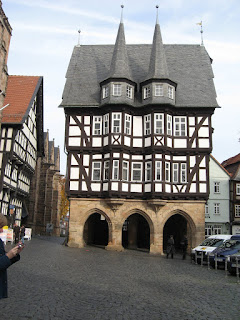Mainz, the birthplace of Gutenberg( 1498) is also a city with deep ties to the past. Eleven museums beckon the historically astute traveler. The city itself has an ancient heritage, claiming to be the first Roman encampment in 38 BC and later established by Drusus in 13 BC as the capital of Upper Germany. Here was constructed the largest theater north of the Alps around 300 AD. At about 400 AD Roman rule came to an end. Archbishops then dominated the scene. Their influence was profound in the architecture, the arts, and during the crusades, on the unfortunate Jewish community in their midst. On our visit the Cathedral of Mainz was celebrating 1000 years in 2009. The late gothic cloister is an imposing structure towering over the bustling Christmas market.
 The majority of our day was spent in the Gutenberg Museum, the home of an array of displays covering over a 1000 years of printing history. Several floors of this expansive collection include artifacts, books, printing processes and machines of not only German, but most European countries, China Japan and the works from the Muslim world. It would take days to study it all, although it is laid out for both the scholar and layman alike. There was sufficient reading material in English to make sense of what we were looking at, but the scope of the exhibit allowed for a contribution to the knowledge at whatever level one was approaching it.
The majority of our day was spent in the Gutenberg Museum, the home of an array of displays covering over a 1000 years of printing history. Several floors of this expansive collection include artifacts, books, printing processes and machines of not only German, but most European countries, China Japan and the works from the Muslim world. It would take days to study it all, although it is laid out for both the scholar and layman alike. There was sufficient reading material in English to make sense of what we were looking at, but the scope of the exhibit allowed for a contribution to the knowledge at whatever level one was approaching it.Although Gutenberg never achieved much recognition during his life, he left behind an immeasurable contribution to the cultural, scientific, literary and religious climate of the renaisssance period and beyond. Johannes Gutenberg said the idea of of incorporating a removable type came to him "as a ray of light". The idea itself, clearly generated time and cost savings from the previous script form or reproduction. It would take time before the true significance of this invention would begin to realize its immense benefits. It began slowly with works of poetry and then the landmark printing of what is referred to as the Gutenberg Bible. It alone can be described as a critical element in the reformation which was to change the face of Europe. To quote another site:
Gutenberg's contribution to printing was the development of a punch and mold system which allowed the mass production of the movable type used to reproduce a page of text. These letters would be put together in a type tray which was then used to print a page of text. If a letter broke down, it could be replaced. When the printing of the copies of one page was finished, the type could be reused for the next page or the next book.
It was Frankfurt that was an early center for printing and so it sponsored a book fair which drew publishers, booksellers, collectors and scholars where they could find what they needed for their livelihoods. This helped coordinate supply and demand which in turn spurned the literary movement and perhaps defined the essence of the meaning of "renaissance."
Housed in what was referred to as a "strong room" were two copies of the Gutenberg Bible. These are the prizes of the collection and for good reason. We owe much to Martin Luther and Gutenburg for making accessible to all knowledge and consequently some of the freedoms we enjoy today.
Although this blog entry offers little in terms of visual appeal, I hope it at leaves the impression that this form of cultural pursuit is also worthy of your time.
























